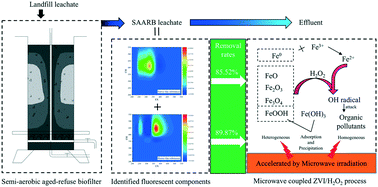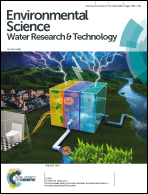Degradation of leachate from a semi-anaerobic aged refuse biofilter by the ZVI/H2O2 process coupled with microwave irradiation: optimization, organics transformation, and reaction mechanisms†
Abstract
The semi-aerobic aged refuse biofilter (SAARB) is highly efficient in removing organic matter and ammonia nitrogen, but the effluent of the SAARB (SAARB leachate) contains high concentrations of recalcitrant organics. In this study, zero valent iron and hydrogen peroxide (ZVI/H2O2) coupled with microwave irradiation were used to treat the SAARB leachate. The effects of the initial pH, ZVI dosage, H2O2 dosage, microwave (MW) power, and reaction time were systematically investigated. Results showed that under optimum conditions [initial pH of 3.0, (ZVI)0 = 0.2 g L−1, (H2O2)0 = 7.5 mL L−1, MW power = 450 W and reaction time = 14 min], the removal efficiencies of chemical oxygen demand, substances absorbing ultraviolet light at 254 nm, and reductions of color number were 28.11%, 48.60%, and 81.21%, respectively. In control experiments, the best treatment was achieved in the combined MW-ZVI/H2O2 process, which indicated a synergetic treatment effect of MW, ZVI and H2O2. Two fluorescent components were identified by parallel factor analysis as fulvic-like substances and humic-like substances. Both of these substances were greatly degraded in the MW-ZVI/H2O2 process, resulting in a sharp reduction of organic matter concentration, molecular weight, and condensation degree, and a significant improvement in the biodegradability of the resulting effluent. Various analyses showed that iron ions could be leached from ZVI, generating iron-based oxides (e.g., FeO, Fe2O3, and FeOOH) in particles of ZVI, which may catalyze the Fenton process. Therefore, in the MW-ZVI/H2O2 process, the removal mechanism of fulvic- and humic-like substances included heterogeneous and homogeneous Fenton reactions, and adsorption and precipitation of iron-based oxides, all of which were promoted by MW energy. As a result, the MW-ZVI/H2O2 process was highly efficient in treating the SAARB leachate.



 Please wait while we load your content...
Please wait while we load your content...